Soviet Union 1945 to 1975
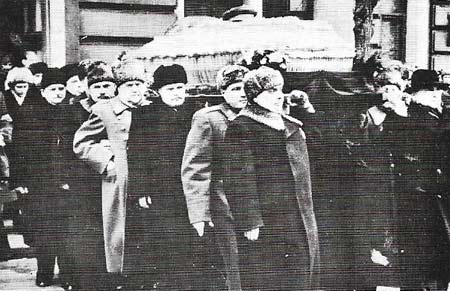
Figure 1. Stalin's funeral on 9 March 1953, drew crowds of Russians to Red Square in Moscow. Not everyone mourned. Some grieved for the man who had transformed their country into a powerful state, but others counted the cost. Without abandoning police control or strict censorship, Stalin's successors eradicated the "personality cult" and the rule of terror. Stalin's body was removed from the Lenin Mausoleum in 1961.
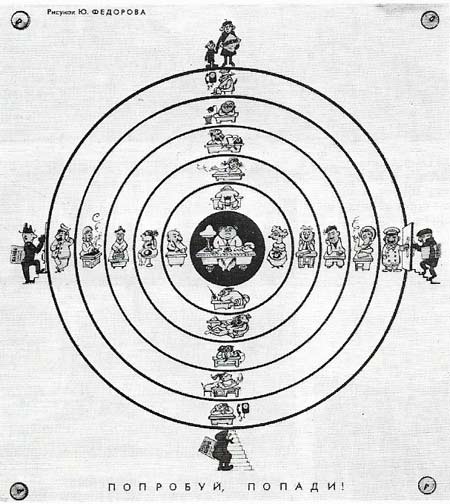
Figure 2. This Soviet cartoon satirizes the inadequacy of curbs on bureaucracy. Attacks on officialdom are tolerated, but criticism of higher officials and Party policy is banned.
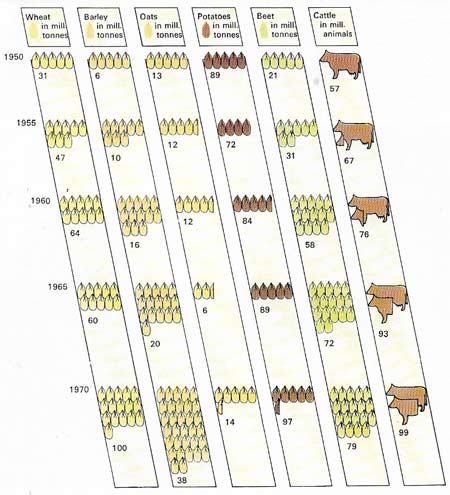
Figure 3. Output of Soviet agriculture was disappointing after collectivization. Price incentives and doubling of investment in the 1960s raised productivity. In the 1970s, with over 500 million acres under cultivation and a quarter of the workforce engaged in farming, Soviet agriculture was still unable to meet the population's demands for a better diet.
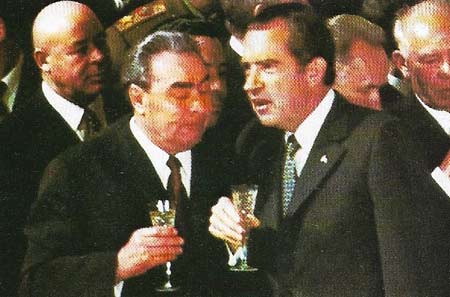
Figure 4. Richard Nixon and Leonid Brezhnev celebrated signing the first agreement on Strategic Arms Limitation (SALT) in 1972. It was designed to stabilize the Soviet-American nuclear relationship and reduce risks of war. Like agreements and trade and agriculture signed during the Nixon-Brezhnev summits, SALT was hampered by suspicions following President Nixon's resignation from the US presidency.
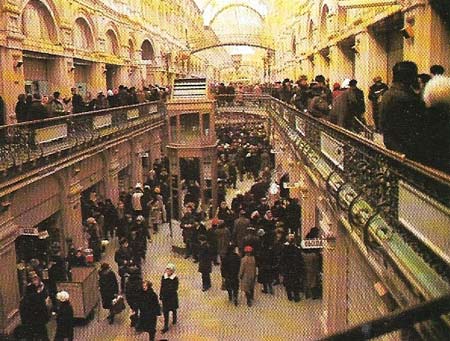
Figure 5. Gosudarstveni Universalni Magasin – GUM – was Moscow's biggest department store, selling anything from luxury fur coats to simple hairpins. Lines abound, but, as in shops elsewhere in the USSR, GUM was better stocked than before, reflecting a rise in general living standards.
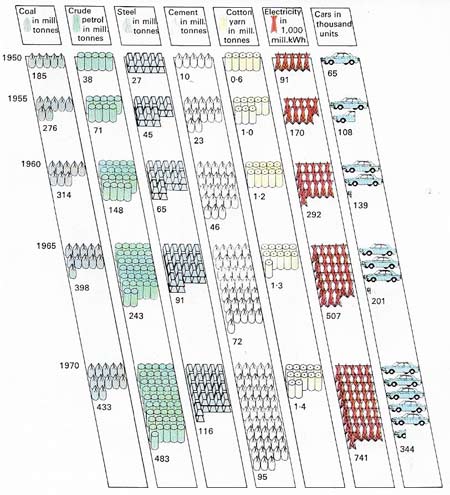
Figure 6. Soviet industrial development after the war was impressive, even allowing for statistical exaggerations. In that period output increased tenfold, more than doubling during the 1960s after reforms which gave more scope to individual initiative. Expansion of heavy industry was still stressed, but consumer production grew in importance. Productivity per man however was still lower than in the West, hence the Soviet interest in Western technology.
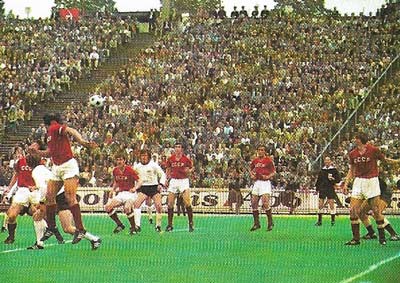
Figure 7. International football matches drew great crowds in Moscow. Sport received generous official encouragement, as part of the view that physical accomplishment made for healthy, contented citizens and international prestige.
The USSR at the end of World War II had lost more than 20 million of her citizens and four and a half million homes. Some 65,000 km (40,000 miles) of railway track were laid waste, thousands of industrial and agricultural machines crippled and livestock vastly depleted. Reconstruction was a formidable task. Joseph Stalin (1879–1953) reintroduced five-year planning, and soon he declared many ambitious targets over-fulfilled.
Costly progress
By the time of Stalin's death the Soviet Union had acquired nuclear weapons and had far surpassed prewar production in iron, steel, coal, oil, and electricity. It achieved these targets at the cost of great sacrifices by its own people and those of Eastern Europe, whose resources were in effect put at Moscow's disposal after 1945.
Life was hardest in the countryside where under-investment, low prices for compulsory deliveries, high taxes on private plots and doctrinaire administrative measures hampered production. By 1953 agricultural output per capita was below that of 1928.
The onset of the Cold War together with Stalin's attempts to contain the effect of Tito's independent line in Yugoslavia increased tension within the USSR. Stalin's "personality cult" reached its peak in the postwar era when purges were revived. Stalin's paranoia towards the end of his life and the sense of fear and suspicion he created around him were publicly expressed in January 1953 when he unjustly accused nine eminent doctors, most of them Jewish, of having murdered the deputy premier, Andrei Zhdanov (1896–1948). In his last days not even Stalin's closest intimates and advisers were safe from his secret police.
Collective leadership
After Stalin's death on 5 March 1953 (Figure 1), "collective leadership" was proclaimed and accordingly the new Premier, Georgi M. Malenkov (1901–1988), relinquished the position of senior Party Secretary ten days after assuming it. Soon the Kremlin doctors were released, their "plot" having been exposed as a fabrication. Curbs on secret-police power were dramatized by the secret trial and execution of Lavrenti Beria (1899–1953), the reorganization of his ministry and the progressive release from labor camps of an estimated 10–12 million people.
There were serious rivalries between Stalin's successors. Premier Malenkov and First Secretary Nikita S. Khrushchev (1894–1971) disagreed over economic priorities and the implications of nuclear warfare, but while Khrushchev exploited their differences to engineer the removal of Malenkov from the premiership in February 1955, he subsequently endorsed many of Malenkov's proposals.
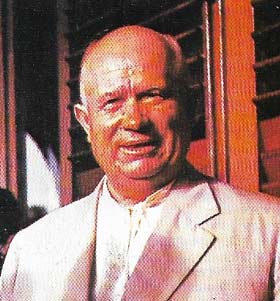 |
| Nikita Khrushchev joined the Communist Party in 1918 and became a loyal executor of Stalin's policies. As First Secretary in the Ukraine in 1938, he administered the purges with fervor. Later, as the Party chief, he dismantled the cruder forms of terror and moved fitfully towards détente. His caprices and bombast infuriated all, yet his consignment to oblivion in 1964 was widely regretted. |
The trend towards relaxing domestic and foreign policies alarmed Foreign Minister Vyacheslav Molotov (1890–1986), especially after the 20th Communist Party Congress in February 1956 at which Khrushchev denounced Stalin and envisaged different roads to socialism. The subsequent turmoil in Poland and Hungary confirmed Molotov's fears. He spearheaded a revolt, culminating in the Party Presidium's vote for Khrushchev's dismissal in June 1957. However, in the Central Committee meeting that followed, Khrushchev's opponents were themselves defeated. Nikolai Bulganin (1895–1975) remained, but lost the premier-ship within a year to Khrushchev himself.
Khrushchev's elevation meant improved material conditions. He cut the working week, reduced wage differentials, diminished the stringency of Stalin's Draconian labor laws, and gave greater priority to consumer needs. But over-centralized, often incompetent planning plagued economic development. Notwithstanding industrial performance (Figure 6) and the Sputniks and other space triumphs after 1957, agricultural production (Figure 3) remained disappointing despite increased investment. Khrushchev's failure aroused resentment and, in October 1964, he was dismissed.
A decade of stable government
Despite policy disagreements, the post-Khrushchev leadership was remarkably stable. Leonid Ilyich Brezhnev (1906–1982), First Secretary of the Central Committee, Alexei Kosygin (1904–1980), Chairman of the Council of Ministers, and Nikolai Viktorovitch Podgorny (1903–1983), President, held office for well over a decade. The USSR advanced militarily to achieve virtual strategic parity with the USA, while the rift with China, begun under Khrushchev, widened. Economic progress was less spectacular. Central planners resisted complete decentralization, but they permitted some degree of autonomy. In agriculture massive investment and concessions such as the relaxation of restrictions on private plots helped to boost production, although major problems remained, despite military and space successes.
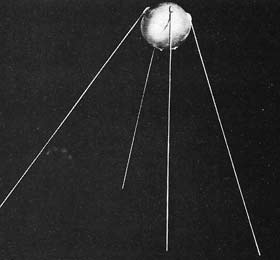 |
| Sputnik I was the world's first artificial satellite. It was launched on 4 October 1957. This success encouraged a whole series of pioneering space ventures. |
Yet there were signs of strain and nonconformity in the monolithic society of the USSR. Alcoholism was one problem, dissidence another. Outspoken intellectuals and writers, such as Sinyaysky and Daniel, along with protesters at political events such as the Soviet intervention in Czechoslovakia in 1968, suffered a harsh official response. But administrative measures failed to silence the nonconformists or stem the clandestine circulation of samizdat (illegal typescripts).
